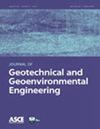离心试验土-容器摩擦对可液化地基板桩抗震响应的影响:数值模拟的启示
IF 3.9
2区 工程技术
Q1 ENGINEERING, GEOLOGICAL
Journal of Geotechnical and Geoenvironmental Engineering
Pub Date : 2023-09-01
DOI:10.1061/jggefk.gteng-11064
引用次数: 1
摘要
作为液化实验和分析项目(LEAP)的一部分,在世界各地六个不同的离心机设施上对板桩挡土墙进行了许多离心机模型试验。各离心机设备采用不同W/H(容器宽度/壁高)比的容器来模拟同一平面应变原型挡土墙。忽略壁面摩擦、假设平面应变条件并使用CycLiq本构模型的离心机试验预测,在液化响应方面与试验表现出合理的总体一致性。然而,对板桩墙体位移的中值响应预测过高。本文中提出的研究的动机是考虑到侧壁上的摩擦可能会使具有不同W/H的模型容器的结果产生偏差。利用FLAC3D进行了数值模拟参数化研究,说明了界面摩擦和容器几何形状对LEAP挡土墙试验结果的潜在影响。结果表明,适当考虑容器几何形状和土-容器摩擦力,可以减小板桩模拟位移与试验位移之间的误差。土-容器摩擦也会影响板桩总土压力,特别是其在板桩壁上的分布,导致实际试验与预定的平面应变条件存在偏差。对于评估的液化相关案例,土-容器摩擦具有显著限制超孔隙压力局部发展和随后土体变形的附加效应,进一步影响离心试验。参数化研究表明,当界面摩擦角为17.6°,W/H>1、2和3时,与忽略壁面摩擦的模拟相比,壁面水平位移分别减少50%、20%和10%。因此,建议在未来的离心机实验中使用具有大W/H的容器。本文章由计算机程序翻译,如有差异,请以英文原文为准。
Influence of Centrifuge Test Soil-Container Friction on Seismic Sheet-Pile Wall Response in Liquefiable Deposit: Insights from Numerical Simulations
As part of the LEAP (Liquefaction Experiments and Analysis Projects), many centrifuge model tests on a sheet pile retaining wall were conducted at six different centrifuge facilities around the world. Each centrifuge facility used containers of different W/H (width of container/height of wall) ratios to model the same plane strain prototype retaining wall. Predictions of the centrifuge tests that neglected wall friction, assumed plane strain conditions, and used the CycLiq constitutive model, exhibit reasonable general agreement with tests in terms of liquefaction response. However, an overprediction of the median response of sheet pile wall displacement was observed. The study presented in this paper was motivated by a concern that friction on the side walls might be biasing results from model containers with different W/H. A numerical simulation parametric study using FLAC3D is presented to illustrate the potential effects of interface friction and container geometry on the LEAP retaining wall test results. The results show that incorporation of appropriate container geometry and soil-container friction can reduce the error between simulated and experimental sheet pile wall displacements. Soil-container friction is also shown to affect the total earth pressure and especially its distribution on the sheet pile wall, causing the actual tests to deviate from the intended plane strain conditions. For the assessed liquefaction related cases, soil-container friction has the additional effect of significantly restricting the local development of excess pore pressure and subsequent soil deformation, further contributing to its influence on the centrifuge tests. The parametric study indicates that an interface friction angle of 17.6° and W/H>1, 2, and 3 reduced horizontal wall displacements by 50%, 20%, and 10% respectively, compared to simulations neglecting wall friction. Use of containers with large W/H is therefore recommended for future centrifuge experiments.
求助全文
通过发布文献求助,成功后即可免费获取论文全文。
去求助
来源期刊
CiteScore
7.50
自引率
7.70%
发文量
222
审稿时长
12 months
期刊介绍:
The Journal of Geotechnical and Geoenvironmental Engineering covers the broad area of practice known as geotechnical engineering. Papers are welcomed on topics such as foundations, retaining structures, soil dynamics, engineering behavior of soil and rock, site characterization, slope stability, dams, rock engineering, earthquake engineering, environmental geotechnics, geosynthetics, computer modeling, groundwater monitoring and restoration, and coastal and geotechnical ocean engineering. Authors are also encouraged to submit papers on new and emerging topics within the general discipline of geotechnical engineering. Theoretical papers are welcomed, but there should be a clear and significant potential for practical application of the theory. Practice-oriented papers and case studies are particularly welcomed and encouraged.

 求助内容:
求助内容: 应助结果提醒方式:
应助结果提醒方式:


